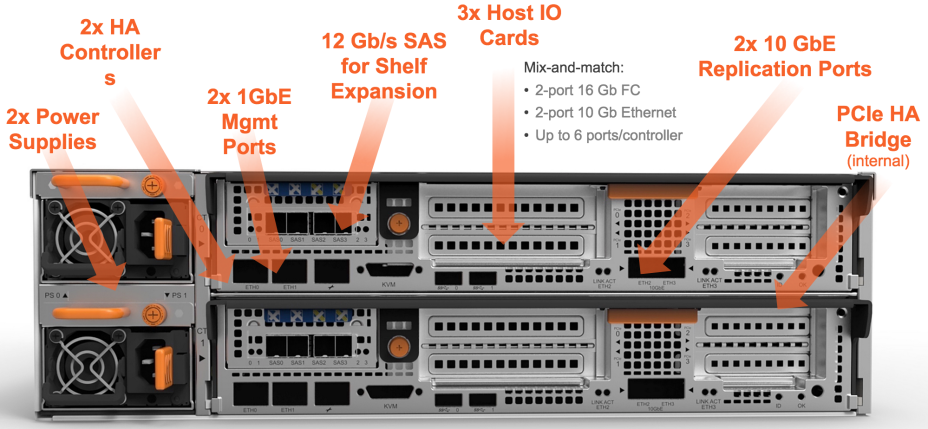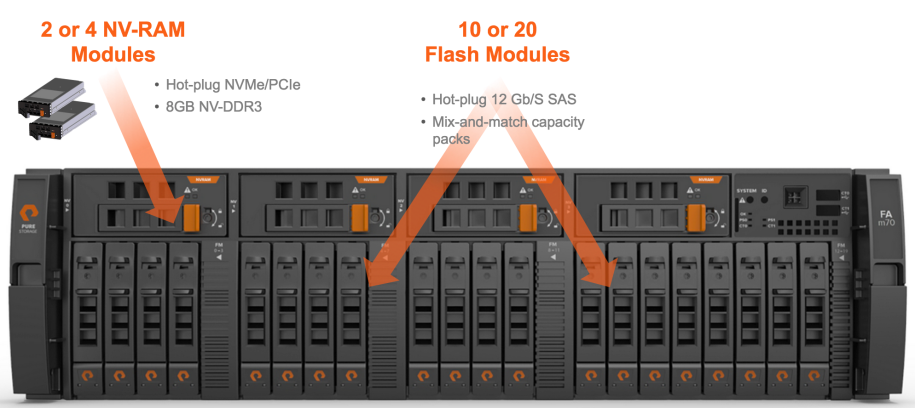The FlashArray//m is here and I wanted to give you a first look at what’s new along with covering 3 main differentiators this storage solution brings to market.
Riding the Commodity Wave (CPU and NAND)
As with previous generations of FlashArray, Pure Storage set out to make All-Flash economically viable for Enterprises by designing Data Reduction into the core solution and riding the commodity hardware wave by standardising on x86 processor technologies leveraging Moore’s law.
With the FlashArray//m we’re building on this approach to leverage the economic benefits of Flash NAND density increases and have introduced new technologies like 12 Gb/s SAS, PCIe and NVMe enabling us to support more performant Flash technologies as they are released to market.
1. Modular Approach
FlashArray//m is a 3RU storage array which takes a ‘Modular’ approach to all components in the solution, we’ve moved to an all-in-one chassis ‘appliance’ design bringing together simplicity and expandability.
Introducing new NV-RAM Modules, Flash Modules and Controller Modules means you can increase storage density and storage performance independently, while retaining an ‘appliance’ like simplicity of management.

2. Upgrade Capacity and Performance
A single 3RU Chassis you can go from 5TB to 40TB raw (not including Data Reduction), thanks to 20 Flash Module slots which can accommodate different capacities, these are separated into 2 groups of 10 with the following configurations available with this initial release: –

Additional external shelves can also be connected to increase storage capacity beyond these amounts.
The FlashArray//m comes with 2 NV-RAM modules as standard and can be expanded to 4 to increase performance.
This design approach enables an easy transition from previous FlashArray controller models, along with the ability to add larger capacity Flash Modules as denser NAND technologies become generally available.
This can include taking advantage of Forever Flash and upgrading your Controllers free of charge (you heard that right) without any downtime or performance impact.
3. Availability
As you’d come to expect with any Storage Platform there’s plenty of availability and redundancy built into the FlashArray//m with dual power supplies shared across the chassis and dual Controller modules which provide High Availability utilising a non-transparent PCIe bridge.
All Modular components are hot swappable in keeping with our ‘storage without compromise’ approach to maintaining availability without compromising performance.
Each Controller has the following interfaces: –
- Dual Management 1GbE ethernet ports
- 4 x 12Gb/s Mini-SAS HD ports
- Up to 3 x PCIe Host IO Cards (2-port 8/16Gb Fibre Channel or 2-port 10GbE iSCSI)
- Dual 10GbE Replication Ports.

Final Word
I hope you found this Overview of the FlashArray//m of interest, over the next few weeks I’ll expand on some of the key technology components that make up this solution along with some of the philosophy behind these design decisions.



Pingback: Pure Storage FlashArray//m Deep Dive | craigwaters.org·
Pingback: Pure Storage FlashArray//m Deep Dive·
Hello Craig,
When I connect two Pure back to back over the 1G/10G replication port, the replication traffic will flow only from this link of it will also require SAN connectivity?
Over the WAN cloud if I want to setup replication, then in that case can I connect both the storages to respective LAN and can they communicate over the WAN cloud?
Regards,
LikeLike
Hi Mayank,
The replication ports on each FlashArray controller are dedicated to provide IP based replication traffic between arrays. They are not used for SAN connectivity.
Currently we support IP based traffic replication between FlashArray’s there is no requirement for ISL or FC based replication. Hope this helps, I recommend you head over to https://support.purestorage.com to find out more details about replication, or use the built in user guide on your FlashArray GUI?
Hope this helps? Thanks, Craig!
LikeLike